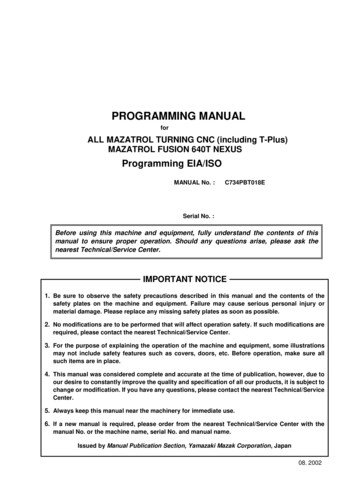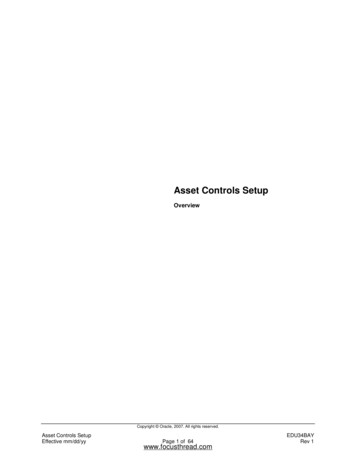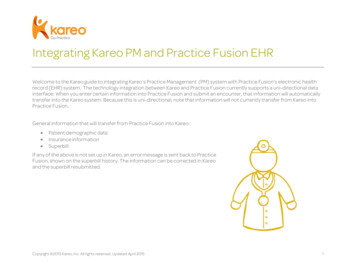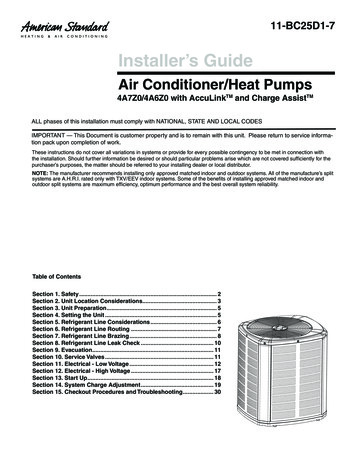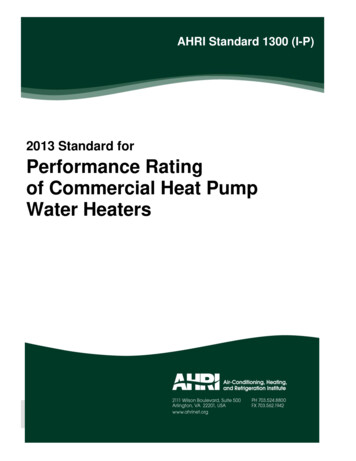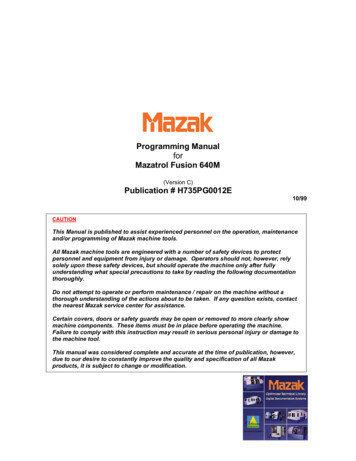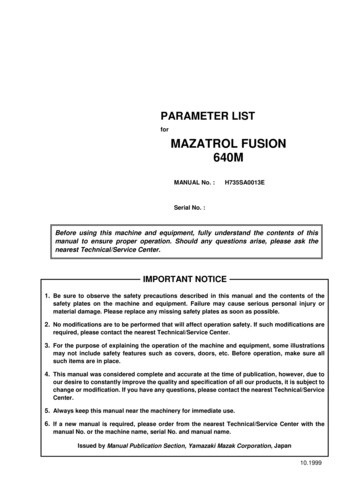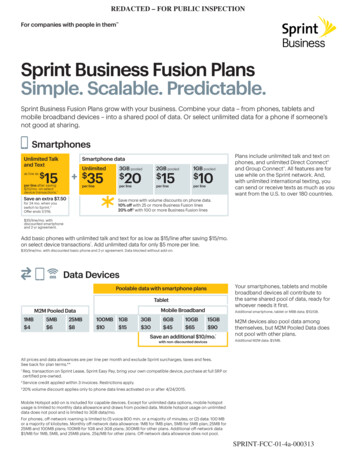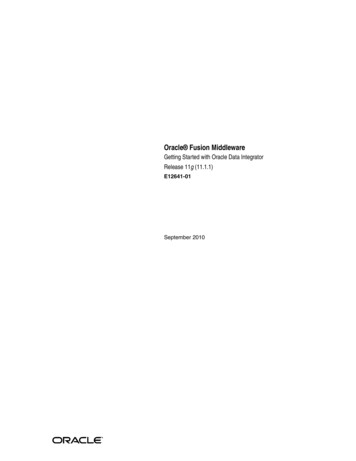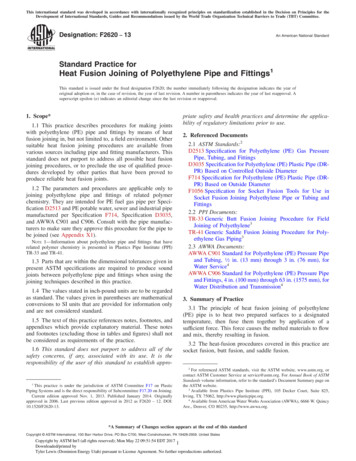
Transcription
This international standard was developed in accordance with internationally recognized principles on standardization established in the Decision on Principles for theDevelopment of International Standards, Guides and Recommendations issued by the World Trade Organization Technical Barriers to Trade (TBT) Committee.Designation: F2620 13An American National StandardStandard Practice forHeat Fusion Joining of Polyethylene Pipe and Fittings1This standard is issued under the fixed designation F2620; the number immediately following the designation indicates the year oforiginal adoption or, in the case of revision, the year of last revision. A number in parentheses indicates the year of last reapproval. Asuperscript epsilon ( ) indicates an editorial change since the last revision or reapproval.1. Scope*1.1 This practice describes procedures for making jointswith polyethylene (PE) pipe and fittings by means of heatfusion joining in, but not limited to, a field environment. Othersuitable heat fusion joining procedures are available fromvarious sources including pipe and fitting manufacturers. Thisstandard does not purport to address all possible heat fusionjoining procedures, or to preclude the use of qualified procedures developed by other parties that have been proved toproduce reliable heat fusion joints.1.2 The parameters and procedures are applicable only tojoining polyethylene pipe and fittings of related polymerchemistry. They are intended for PE fuel gas pipe per Specification D2513 and PE potable water, sewer and industrial pipemanufactured per Specification F714, Specification D3035,and AWWA C901 and C906. Consult with the pipe manufacturers to make sure they approve this procedure for the pipe tobe joined (see Appendix X1).NOTE 1—Information about polyethylene pipe and fittings that haverelated polymer chemistry is presented in Plastics Pipe Institute (PPI)TR-33 and TR-41.1.3 Parts that are within the dimensional tolerances given inpresent ASTM specifications are required to produce soundjoints between polyethylene pipe and fittings when using thejoining techniques described in this practice.1.4 The values stated in inch-pound units are to be regardedas standard. The values given in parentheses are mathematicalconversions to SI units that are provided for information onlyand are not considered standard.1.5 The text of this practice references notes, footnotes, andappendixes which provide explanatory material. These notesand footnotes (excluding those in tables and figures) shall notbe considered as requirements of the practice.1.6 This standard does not purport to address all of thesafety concerns, if any, associated with its use. It is theresponsibility of the user of this standard to establish appro-1This practice is under the jurisdiction of ASTM Committee F17 on PlasticPiping Systems and is the direct responsibility of Subcommittee F17.20 on Joining.Current edition approved Nov. 1, 2013. Published January 2014. Originallyapproved in 2006. Last previous edition approved in 2012 as F2620 – 12. DOI:10.1520/F2620-13.priate safety and health practices and determine the applicability of regulatory limitations prior to use.2. Referenced Documents2.1 ASTM Standards:2D2513 Specification for Polyethylene (PE) Gas PressurePipe, Tubing, and FittingsD3035 Specification for Polyethylene (PE) Plastic Pipe (DRPR) Based on Controlled Outside DiameterF714 Specification for Polyethylene (PE) Plastic Pipe (DRPR) Based on Outside DiameterF1056 Specification for Socket Fusion Tools for Use inSocket Fusion Joining Polyethylene Pipe or Tubing andFittings2.2 PPI Documents:TR-33 Generic Butt Fusion Joining Procedure for FieldJoining of Polyethylene3TR-41 Generic Saddle Fusion Joining Procedure for Polyethylene Gas Piping32.3 AWWA Documents:AWWA C901 Standard for Polyethylene (PE) Pressure Pipeand Tubing, 1 2 in. (13 mm) through 3 in. (76 mm), forWater Service4AWWA C906 Standard for Polyethylene (PE) Pressure Pipeand Fittings, 4 in. (100 mm) through 63 in. (1575 mm), forWater Distribution and Transmission43. Summary of Practice3.1 The principle of heat fusion joining of polyethylene(PE) pipe is to heat two prepared surfaces to a designatedtemperature, then fuse them together by application of asufficient force. This force causes the melted materials to flowand mix, thereby resulting in fusion.3.2 The heat-fusion procedures covered in this practice aresocket fusion, butt fusion, and saddle fusion.2For referenced ASTM standards, visit the ASTM website, www.astm.org, orcontact ASTM Customer Service at service@astm.org. For Annual Book of ASTMStandards volume information, refer to the standard’s Document Summary page onthe ASTM website.3Available from Plastics Pipe Institute (PPI), 105 Decker Court, Suite 825,Irving, TX 75062, http://www.plasticpipe.org.4Available from American Water Works Association (AWWA), 6666 W. QuincyAve., Denver, CO 80235, http://www.awwa.org.*A Summary of Changes section appears at the end of this standardCopyright ASTM International, 100 Barr Harbor Drive, PO Box C700, West Conshohocken, PA 19428-2959. United StatesCopyright by ASTM Int'l (all rights reserved); Mon May 22 09:51:54 EDT 20171Downloaded/printed byTyler Lewis (Dominion Energy Utah) pursuant to License Agreement. No further reproductions authorized.
F2620 133.2.1 Procedure 1, Socket Fusion—The socket-fusion procedure involves simultaneously heating the outside surface ofa pipe end and the inside of a fitting socket, which is sized tobe smaller than the smallest outside diameter of the pipe. Afterthe proper melt has been generated at each face to be mated,the two components are joined by inserting one component intothe other. See Fig. 1. The fusion bond is formed at the interfaceresulting from the interference fit. The melts from the twocomponents flow together and fuse as the joint cools. Optionalalignment devices are used to hold the pipe and socket fittingin longitudinal alignment during the joining process; especiallywith pipe sizes IPS 3 in. (89 mm) and larger. Automated socketfusion is not addressed in this procedure.3.2.2 Procedure 2, Butt Fusion—The butt-fusion procedurein its simplest form consists of heating the squared ends of twopipes, a pipe and a fitting, or two fittings, by holding themagainst a heated plate, removing the heater plate when theproper melt is obtained, promptly bringing the ends together,and allowing the joint to cool while maintaining the appropriate applied force.3.2.2.1 An appropriately sized butt fusion machine is usedto clamp, align and face the pipe or fitting ends and to apply thespecified fusion force. See Fig. 2.3.2.3 Procedure 3, Saddle Fusion—The saddle-fusion procedure involves melting the concave surface of the base of asaddle fitting, while simultaneously melting a matching patternon the surface of the pipe, bringing the two melted surfacestogether and allowing the joint to cool while maintaining theappropriate applied force. See Fig. 3.3.2.3.1 An appropriately sized saddle fusion machine isused to clamp the pipe main and the fitting, align the parts andapply the specified fusion force.4. Significance and Use4.1 The procedures described in Sections 7 – 9 are primarilyintended for (but not limited to) field joining of polyethylene(PE) pipe and fittings, using suitable equipment and appropriate environmental control procedures. When properlyimplemented, strong pressure/leak-tight joints are produced.When these joints are destructively tested, the failure occursoutside the fusion joined area.4.2 Melt characteristics, average molecular weight and molecular weight distribution are influential factors in establishingsuitable fusion parameters; therefore, consider the manufacturer’s instructions in the use or development of a specific fusionprocedure. See Annex A1.4.3 The socket fusion, butt fusion, and saddle fusion procedures in this practice are suitable for joining PE gas pipe andfittings, PE water pipe and fittings, and PE general purposepipes and fittings made to PE product specifications fromorganizations such as ASTM, AWWA, API, and ISO that areused in pressure, low pressure and non-pressure applications.For gas applications, qualification of the procedure by testingjoints made using the procedure in accordance with regulationsfrom the authority having jurisdiction are required.5. Operator Experience5.1 Skill and knowledge on the part of the operator arerequired to obtain a good quality joint. This skill and knowledge is obtained by making joints in accordance with provenprocedures under the guidance of skilled operators. Evaluateoperator proficiency by testing sample joints.FIG. 1 Socket FusionCopyright by ASTM Int'l (all rights reserved); Mon May 22 09:51:54 EDT 20172Downloaded/printed byTyler Lewis (Dominion Energy Utah) pursuant to License Agreement. No further reproductions authorized.
F2620 13FIG. 2 Butt FusionFIG. 3 Saddle Fusion5.2 The party responsible for the joining of polyethylenepipe and fittings shall ensure that detailed procedures developed in conjunction with applicable codes and regulations andthe manufacturers of the pipe, fittings, and joining equipmentinvolved, including the safety precautions to be followed, areissued before actual joining operations begin.6. Apparatus—General Recommendations6.1 Heating Tool—Electric heating tools come in a varietyof sizes that match the fusion machines capabilities. They aredesigned with enough wattage and electronic control to maintain the specified heater face temperature required in thisprocedure. The range of the heater control shall be larger thanthe heating temperature specification (the typical control rangeis 50 F (30 C) above and below the maximum and minimumrequired heating tool surface temperatures. Electric heatingplates maintain consistent fusion temperatures when providedwith an adequate power source.Copyright by ASTM Int'l (all rights reserved); Mon May 22 09:51:54 EDT 20173Downloaded/printed byTyler Lewis (Dominion Energy Utah) pursuant to License Agreement. No further reproductions authorized.
F2620 136.2 Heating Tool Faces—Heating tools may be made frommaterials such as aluminum, stainless steel, copper, or copperalloys. Polyethylene material may stick to hot metal heatingsurfaces. This sticking may be minimized by applying anon-stick coating to the heating surfaces or by fitting ahigh-temperature, non-stick fabric over the heating surfaces.The heating plate surfaces, coated or uncoated, shall be keptclean and free of contaminants such as dirt, grease and plasticbuild-up, which may cause excessive sticking and createunsatisfactory joints. Most of these contaminants are removedfrom the hot tool surfaces using a clean, dry, lint-free,non-synthetic cloth such as cotton. Do not use synthetic fabricswhich may char and stick to the fusion surface. Somepigments, such as carbon black, may stain a heating surfaceand probably cannot be removed; such stains will not contaminate the joint interface.6.2.1 After a period of time in service, non-stick coatings orfabrics will deteriorate and become less effective. Deterioratedfabrics shall be replaced, and worn, scratched, or gougednon-stick coatings shall be re-coated when they lose effectiveness. Heat fusion quality may be adversely affected by deteriorated non-stick surfaces. Spray-on chemicals, such as nonstick lubricants or oils shall not be applied to heating ironsurfaces as they will contaminate the joint.6.3 Temperature Indicator—Heating tools shall be equippedwith a thermometer or other built-in temperature indicatingdevice. This device indicates the internal temperature of theheating iron, which is usually higher than temperature of theheating tool surfaces. Use a pyrometer, or other temperaturemeasuring device, on the first joint of the day and periodicallyduring the day to verify the temperature of the tool facesurfaces within the pipe or fitting contact area. Select multiplecheckpoints to ensure uniform surface temperature. An infraredpyrometer is calibrated by comparison to a calibrated surfacepyrometer and adjusted to agree on each heating tool.NOTE 2—A significant temperature variation, that is, cold spots, on theheating tool surfaces may indicate a faulty heating iron which may needto be serviced before it can be used.7. Procedure 1—Socket Fusion7.1 Apparatus:7.1.1 Socket Fusion Tools—Socket fusion tools consist of aheating tool, heating tool faces, rounding clamps (cold rings),depth gage/chamfer tools, and pipe/fittings made to ASTMspecifications.7.1.2 Heating Tool—In order to obtain a proper melt, it isnecessary for a uniform temperature to be maintained acrossthe heating tool faces. An electrical tool shall have sufficientwattage and control to maintain the specified surface temperature of the tool faces.7.1.3 Heating Tool Faces—Consisting of two parts, a maleend for the interior socket surface and a female end for theexterior pipe surface. Both parts shall be made to suchtolerances as to cause an interference fit. Heating tool faces areproduced to Specification F1056 dimensions, and are coatedwith a non-stick material to keep melted pipe and fittingmaterial from sticking to the face.7.1.4 Alignment Jig—The alignment jig is an optional toolwhich consists of two sets of devices holding the componentsin alignment to each other. One set of holding devices is fixed,and the other allows longitudinal movement for making thejoint.7.1.5 Rounding Clamps, (cold ring) to maintain roundnessof the pipe and control the depth of pipe insertion into thesocket during the joining operation.7.1.6 Depth Gage, for proper positioning of the roundingclamp on the pipe.7.1.7 Chamfering Tool, to bevel the end of the pipe.NOTE 3—The depth gage and chamfering tool may be combined into asingle tool.7.1.8 Tubing Cutter, to obtain a square end cut on the pipe.7.1.9 Fitting Puller, an optional tool to assist in the removalof the fitting from the heating tool and to hold the fitting duringassembly.7.2
2.1 ASTM Standards:2 D2513 Specification for Polyethylene (PE) Gas Pressure Pipe, Tubing, and Fittings D3035 ) Based on Controlled Outside Diameter F714 Specification for Polyethylene (PE) Plastic Pipe (DR-PR) Based on Outside Diameter F1056 Specification for Socket Fusion Tools for Use in Socket Fusion Joining Polyethylene Pipe or
